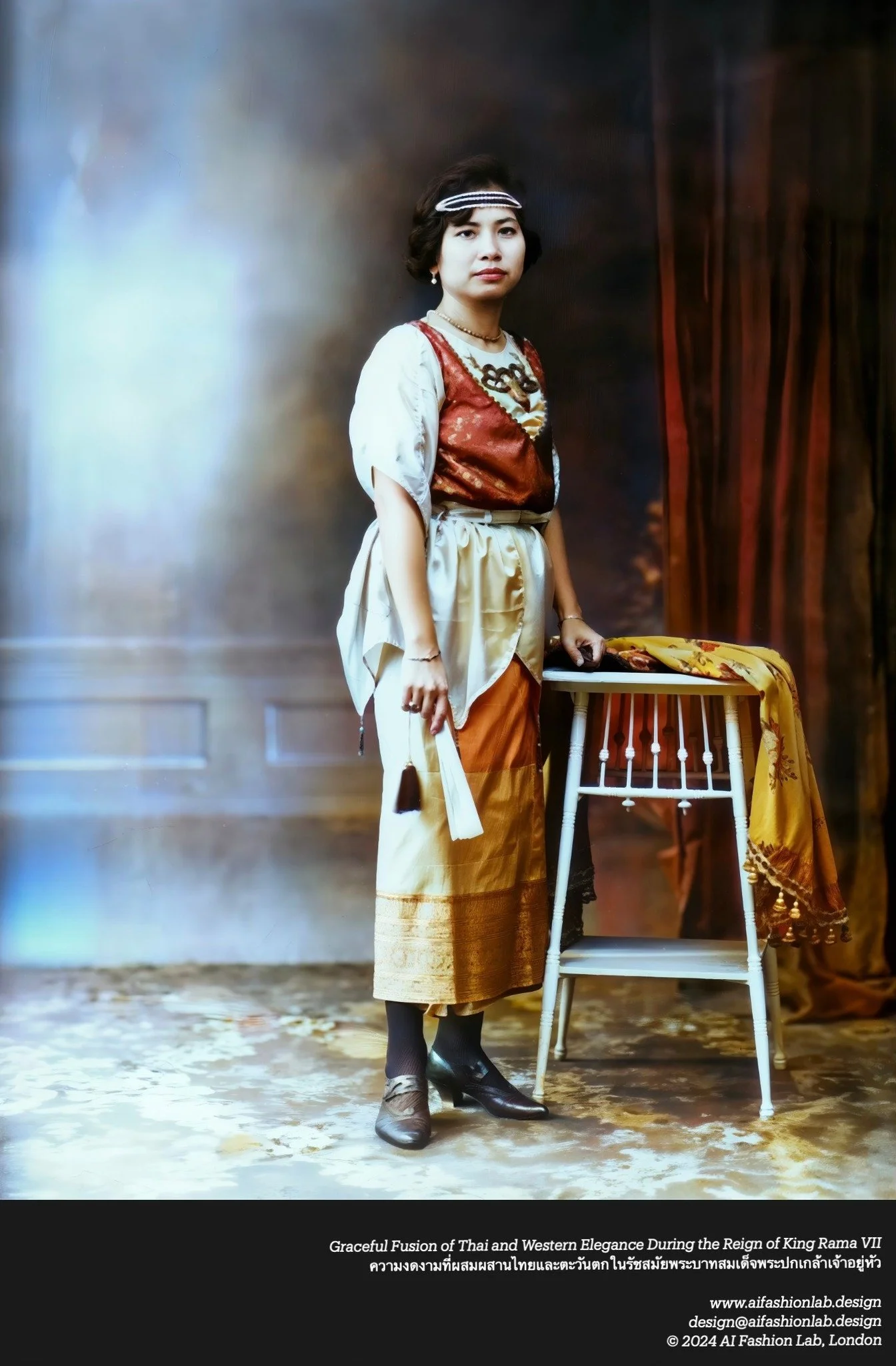Women's Fashion During the Reign of King Rama VI: A Reflection of Society and Culture
Women's Fashion During the Reign of King Rama VI: A Reflection of Society and Culture
This collection showcases the restoration of historical photographs using AI technology, bringing old images of Thai women during the reign of King Rama VI (1910–1925) back to life. By colourising and enhancing these photographs into realistic, 3D-like visuals, these restored images not only highlight the elegance of past fashion but also provide deep insights into the cultural and social contexts of the era.
The reign of King Rama VI marked a golden age of cultural transformation in Siam. Women's fashion during this period went beyond mere clothing—it reflected the social, political, and economic dynamics, harmonising globalisation with the preservation of Thai identity.
Early Reign: Edwardian Influences
In the early reign of King Rama VI, Thai women’s fashion was heavily influenced by the Edwardian era in England. Outfits emphasised elegance and practicality, departing from the restrictive Victorian styles. Siamese women adopted long-sleeved lace blouses with high collars and bell-shaped skirts, replacing traditional jong kraben (wrapped trousers).
Mid-Reign: Transition Towards Thai Identity
As the reign progressed, Thai women began integrating distinctly Siamese elements into their attire. The pha-sin(traditional tubular skirt) became increasingly popular, replacing the jong kraben. Blouses paired with the sin were often made of silk or lace, featuring loose, hip-covering designs that embodied simplicity and elegance.
During this period, women of the royal court started styling their hair in high chignons and incorporated European garments into everyday life while maintaining a uniquely Thai identity.
Late Reign: Modernity Meets Global Influence
By the later years of King Rama VI’s reign, Thai women embraced more modern styles influenced by global trends. Straight-cut dresses, short sleeves, and skirts that fell above the ankle gained popularity. Accessories such as European-style hats and hairstyles like short, wavy cuts or bobbed hair became fashionable.
These changes reflected a clever adaptation to Western culture. While adopting global styles, Thai women retained national pride through details such as traditional textiles and colour choices that signified their heritage.
Fashion as a Social and Political Mirror
Although Western influences were significant, the selective adaptation of fashion by Thai society also mirrored the political stance of Siam during the colonial era. By incorporating elements of Western culture while preserving their own identity, Thai women demonstrated independence and pride in their nation.
Fashion in the reign of King Rama VI (1910–1925) thus became more than attire—it evolved into a discourse that captured the values and mindset of the time. It remains a testament to the creativity and resilience of a society moving towards modernity while holding firmly to its roots.
แฟชั่นสตรีสมัยรัชกาลที่ 6: อาภรณ์ที่สะท้อนบริบททางสังคมและวัฒนธรรม
คอลเล็กชันเภาพเหล่านี้เป็นภาพที่ได้รับการบูรณะด้วยเทคโนโลยีเอไอ โดยการลงสีและปรับแต่งภาพให้มีความสมจริงในรูปแบบสามมิติ มาจากภาพถ่ายเก่าของสตรีไทยในสมัยรัชกาลที่ 6 (พ.ศ. 2453 ถึง พ.ศ. 2468 หรือ 1910 to 1925) เพื่อฟื้นคืนชีวิตให้ภาพเหล่านี้ดูเสมือนบุคคลจริง ภาพเหล่านี้ไม่เพียงแค่สะท้อนความงดงามของแฟชั่นในอดีต แต่ยังนำเสนอเรื่องราวทางวัฒนธรรมและบริบททางสังคมในยุคนั้นได้อย่างลึกซึ้ง
สมัยรัชกาลที่ 6 หรือยุคทองแห่งการเปลี่ยนแปลงทางวัฒนธรรมในสยาม แฟชั่นสตรีในยุคนี้ไม่ได้เป็นเพียงเครื่องแต่งกาย แต่ยังเป็นภาพสะท้อนบริบททางสังคม การเมือง และเศรษฐกิจ ที่เชื่อมโยงกับกระแสโลกาภิวัตน์และการอนุรักษ์เอกลักษณ์ความเป็นไทยได้อย่างกลมกลืน
ช่วงต้นรัชกาล: อิทธิพลจากยุคเอ็ดเวอร์เดียน
ในช่วงต้นรัชกาลที่ 6 แฟชั่นสตรีไทยรับอิทธิพลอย่างมากจากยุคเอ็ดเวอร์เดียน (Edwardian Era) ของอังกฤษ เสื้อผ้าเน้นความสง่างามและโครงสร้างที่ลดความอึดอัดของยุควิกตอเรีย สตรีสยามเริ่มสวมเสื้อลูกไม้แขนยาว คอสูง กระโปรงทรงกระดิ่งแทนการใส่โจงกระเบนแบบดั้งเดิม
ช่วงกลางรัชกาล: การปรับตัวสู่เอกลักษณ์ไทย
เมื่อเข้าสู่ช่วงกลางรัชกาล การแต่งกายของสตรีไทยเริ่มปรับตัวไปในทิศทางที่สะท้อนเอกลักษณ์ของสยาม สตรีในยุคนี้เริ่มนิยมการนุ่งซิ่นแทนโจงกระเบน โดยเสื้อที่สวมใส่ถูกออกแบบให้เข้ากับซิ่น ทั้งจากผ้าแพรและลูกไม้ เสื้อทรงหลวมยาวคลุมสะโพก เป็นสไตล์ที่แสดงความเรียบง่ายแต่สง่างาม ช่วงนี้ยังเป็นยุคที่เจ้านายฝ่ายหญิงเริ่มเกล้าผมแบบมวยสูง และปรับใช้เสื้อผ้าสไตล์ยุโรปในชีวิตประจำวัน โดยยังคงเอกลักษณ์ไทยไว้อย่างชัดเจน
ช่วงปลายรัชกาล: ความทันสมัยในยุคทีนส์ตอนปลาย
ในช่วงปลายรัชกาล แฟชั่นสตรีไทยก้าวสู่ความทันสมัยมากขึ้นตามกระแสโลกาภิวัตน์ เสื้อผ้าทรงตรง แขนสั้น และกระโปรงที่มีความยาวเหนือข้อเท้าได้รับความนิยม ผู้หญิงไทยเริ่มสวมหมวกสไตล์ยุโรป ตัดผมสั้นดัดเป็นลอนคลื่นหรือทรงบ๊อบแบบตะวันตก
ความเปลี่ยนแปลงนี้สะท้อนถึงการเปิดรับวัฒนธรรมตะวันตกอย่างชาญฉลาด สตรีไทยยังคงรักษาความเป็นไทยไว้ในรายละเอียด เช่น การใช้ผ้าซิ่นหรือการเลือกสีที่สื่อถึงเอกลักษณ์ของชาติ
แฟชั่น: ภาพสะท้อนสังคมและรัฐศาสตร์
แม้แฟชั่นในยุคนั้นจะได้รับอิทธิพลจากตะวันตก แต่การปรับใช้ของคนไทยยังสะท้อนถึงจุดยืนทางรัฐศาสตร์ในยุคล่าอาณานิคม สตรีไทยเลือกที่จะรับเพียงบางส่วนของวัฒนธรรมตะวันตก โดยยังคงกลิ่นอายความเป็นสยาม เพื่อแสดงถึงความเป็นอิสระและความภาคภูมิใจในชาติ
แฟชั่นในสมัยรัชกาลที่ 6 (พ.ศ. 2453 ถึง พ.ศ. 2468 หรือ 1910 to 1925) จึงไม่ได้เป็นเพียงเครื่องแต่งกาย แต่เป็นวาทกรรมที่บอกเล่าความคิดและค่านิยมของยุคสมัยได้อย่างงดงาม มันเป็นบทพิสูจน์ถึงความคิดสร้างสรรค์และความยืดหยุ่นของสังคมที่กำลังเดินหน้าสู่ความทันสมัยโดยไม่ละทิ้งรากฐานของตนเอง
#aifashionlab #AI #aiartist #aiart #aifashion #aifashiondesign #aifashionstyling #aifashiondesigner #fashion #fashionhistory #historyoffashion #fashionstyling #fashionphotography #digitalfashion #digitalfashiondesign #digitalcostumedesign #digitaldesign #digitalaiart #promptography #promptographer #prompts #fashionpromptograph








